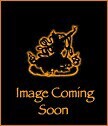
Item: Amitabha Buddha - Pureland (Sukhavati)
| Origin Location | Tibet |
|---|---|
| Date Range | 1800 - 1899 |
| Lineages | Nyingma, Karma (Kagyu) and Buddhist |
| Material | Ground Mineral Pigment on Cotton |
| Collection | Private |
Classification: Deity
Appearance: Buddha
Gender: Male
Amitabha Buddha (Tibetan: o pa me, sang gye, English: the Enlightened One of Immeasurable Light) according to the tradition of Namcho Mingyur Dorje.
Amitabha, gold in colour, is seated in front of a large palace with Avalokiteshvara, with four arms, at the left and Vajrapani at the right, the remaining six of the Eight Great Bodhisattvas sit in front. Outside of the palace are sixteen offering goddesses, all with different body colours, dancing and holding up rare and precious substances. At the lower sides of the composition are Karma Kagyu and Nyingma lineage masters, seated outside of the palace courtyard.
At the top of the composition are the Five Symbolic Buddhas in spheres of light: yellow Ratnasambhava, white Vairochana, red Amitabha, blue Akshobhya and green Amoghasiddhi. Below that are pictured Vairochana and Amoghasiddhi, white and green, seated within small palaces along with attendants. Below that, standing on white clouds, are the Buddhas of the Ten Directions, five on the right and five on the left. Below those are the Buddhas of the Six Realms.
At the lower right and left of the composition are the Buddhas Ratnsambhava and Akshobhya in their palaces. In a small vignette on the left side is Chaturbhuja Lokeshshvara accompanied by White Tara and Green Tara.
At the bottom center is Shakyamuni Buddha. In the bottom right corner are two protectors Shingkyong Yab-yum.
The style of painting is Kham-dri commonly found in Eastern Tibet. With this particular painting it follows very close in drawing and composition to the specific Palpung style of Palpung monastery also in Eastern Tibet, Dege Region. It should be noted that it is not Karma Gardri style (16th/17th century) nor is it the contentious and problematic style referred to nowadays as 'New Karma Gardri' which is commonly used to describe either the popular style of Palpung monastery in the 18th and 19th centuries, or ALL paintings from the Kham region that do not follow a readily identifiable Menri or Khyenri style of Central Tibet.
Jeff 3-2016
Collection of Dhargye Museum (Painting Gallery 1)
Buddhist Deity: Amitabha Buddha Main Page (阿弥陀佛 / འོད་དཔག་མེད།)
Subject: Sukhavati Paintings (Namcho Tradition)
Collection of Dhargye Museum
